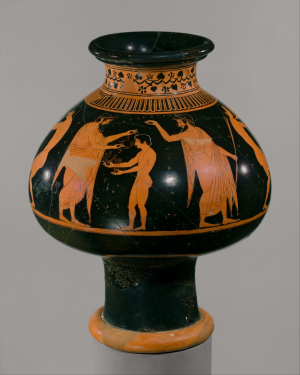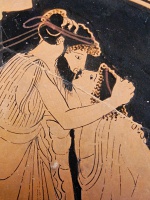Gymnasium (ancient Greece): Difference between revisions
No edit summary |
No edit summary |
||
| (3 intermediate revisions by one other user not shown) | |||
| Line 1: | Line 1: | ||
[[File:Young Athletes and Their Trainers Practicing in a Gymnasium.png|thumb|right|Young Athletes and Their Trainers Practicing in a Gymnasium. Terracotta psykter (vase for cooling wine). Attributed to Oltos. Archaic, ca. 520–510 B.C. Greek, Attic. Red-figure. New York, Metropolitan Museum of Art, 10.210.18.]] | |||
The '''gymnasium''' in [[Ancient Greece]] functioned as a training facility for male competitors in public games. It was also a place for socializing and engaging in intellectual pursuits. The name comes from the Ancient Greek term ''gymnós'' meaning "naked". Athletes competed nude, a practice said to encourage aesthetic appreciation of the male body, and to be a tribute to the gods. Gymnasia and [[palaestra|palestrae]] (wrestling schools) were under the protection and patronage of [[Heracles]], [[Hermes]] and, in Athens, [[Theseus]].<ref>Pausanias (geographer), ''Guide to Greece,'' 4.32.1</ref> The whole education of a Greek boy was divided into four parts: grammar, music, the art of drawing or painting, and gymnastics. <ref> Plato, Theog. p122; Plut. de Audit. 17; Clitoph. p497</ref> <ref>Aristotle (de Republ. VIII.3)</ref> The gymnasium was a school which also included baths and philosophic groves and it's development arose through recognition by the Greeks of the strong relation between athletics, education and health. Accordingly, the gymnasium became connected with education on the one hand and medicine on the other. Physical training and maintenance of health and strength were the chief parts of children's earlier education. Except for time devoted to letters and music, the education of young men was solely conducted in the gymnasium, where provisions were made not only for physical pedagogy but for instruction in morals and ethics. As pupils grew older, informal conversation and other forms of social activity took the place of institutional, systematic discipline. Since the gymnasia were favorite resorts of youth, they were frequented by teachers, especially philosophers. Philosophers and sophists frequently assembled to hold talks and lectures in the gymnasia; thus the institution became a resort for those interested in less structured intellectual pursuits in addition to those using the place for training in physical exercises. | The '''gymnasium''' in [[Ancient Greece]] functioned as a training facility for male competitors in public games. It was also a place for socializing and engaging in intellectual pursuits. The name comes from the Ancient Greek term ''gymnós'' meaning "naked". Athletes competed nude, a practice said to encourage aesthetic appreciation of the male body, and to be a tribute to the gods. Gymnasia and [[palaestra|palestrae]] (wrestling schools) were under the protection and patronage of [[Heracles]], [[Hermes]] and, in Athens, [[Theseus]].<ref>Pausanias (geographer), ''Guide to Greece,'' 4.32.1</ref> The whole education of a Greek boy was divided into four parts: grammar, music, the art of drawing or painting, and gymnastics. <ref> Plato, Theog. p122; Plut. de Audit. 17; Clitoph. p497</ref> <ref>Aristotle (de Republ. VIII.3)</ref> The gymnasium was a school which also included baths and philosophic groves and it's development arose through recognition by the Greeks of the strong relation between athletics, education and health. Accordingly, the gymnasium became connected with education on the one hand and medicine on the other. Physical training and maintenance of health and strength were the chief parts of children's earlier education. Except for time devoted to letters and music, the education of young men was solely conducted in the gymnasium, where provisions were made not only for physical pedagogy but for instruction in morals and ethics. As pupils grew older, informal conversation and other forms of social activity took the place of institutional, systematic discipline. Since the gymnasia were favorite resorts of youth, they were frequented by teachers, especially philosophers. Philosophers and sophists frequently assembled to hold talks and lectures in the gymnasia; thus the institution became a resort for those interested in less structured intellectual pursuits in addition to those using the place for training in physical exercises. | ||
Many relationships between Greek "boylovers" and their beloveds were either begun, or fostered by, contacts between adult males and [[peri-pubescent]] or [[puberty|pubescent]] youths meeting at the gymnasiums. | Many relationships between Greek "boylovers" and their beloveds were either begun, or fostered by, contacts between adult males and [[peri-pubescent]] or [[puberty|pubescent]] youths meeting at the gymnasiums. | ||
{{clr}} | |||
==References== | ==References== | ||
{{reflist}} | {{reflist}} | ||
| Line 12: | Line 13: | ||
*[http://penelope.uchicago.edu/Thayer/E/Roman/Texts/secondary/SMIGRA*/Gymnasium.html Gymnasium] | *[http://penelope.uchicago.edu/Thayer/E/Roman/Texts/secondary/SMIGRA*/Gymnasium.html Gymnasium] | ||
*[http://www.theatlantic.com/magazine/archive/1859/05/the-gymnasium/305407/ The Gymnasium] | *[http://www.theatlantic.com/magazine/archive/1859/05/the-gymnasium/305407/ The Gymnasium] | ||
{{Navbox Ancient Greece}} | |||
[[Category:Ancient Greece]] | [[Category:Ancient Greece]] | ||
Latest revision as of 22:39, 2 July 2022

The gymnasium in Ancient Greece functioned as a training facility for male competitors in public games. It was also a place for socializing and engaging in intellectual pursuits. The name comes from the Ancient Greek term gymnós meaning "naked". Athletes competed nude, a practice said to encourage aesthetic appreciation of the male body, and to be a tribute to the gods. Gymnasia and palestrae (wrestling schools) were under the protection and patronage of Heracles, Hermes and, in Athens, Theseus.[1] The whole education of a Greek boy was divided into four parts: grammar, music, the art of drawing or painting, and gymnastics. [2] [3] The gymnasium was a school which also included baths and philosophic groves and it's development arose through recognition by the Greeks of the strong relation between athletics, education and health. Accordingly, the gymnasium became connected with education on the one hand and medicine on the other. Physical training and maintenance of health and strength were the chief parts of children's earlier education. Except for time devoted to letters and music, the education of young men was solely conducted in the gymnasium, where provisions were made not only for physical pedagogy but for instruction in morals and ethics. As pupils grew older, informal conversation and other forms of social activity took the place of institutional, systematic discipline. Since the gymnasia were favorite resorts of youth, they were frequented by teachers, especially philosophers. Philosophers and sophists frequently assembled to hold talks and lectures in the gymnasia; thus the institution became a resort for those interested in less structured intellectual pursuits in addition to those using the place for training in physical exercises.
Many relationships between Greek "boylovers" and their beloveds were either begun, or fostered by, contacts between adult males and peri-pubescent or pubescent youths meeting at the gymnasiums.
